Living Planet
Nature · Earth · ClimateNature Notes: July 2022
MAGNIFICENT MEADOWS
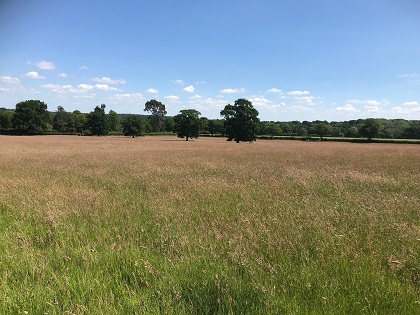
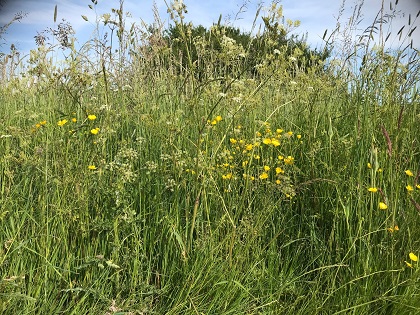
My bare legs feel as if they're being alternatively whipped and tickled by wands of hard and feathered golden seeds (my own fault for wearing shorts) as I wend my way through one of our surrounding meadows, pondering that I've never known them to look as richly varied and resplendent as they do this year! In close up each individual grass and flower is so detailed and beautiful and collectively every strand makes up wide sweeps that weave together and bend in the breeze to create moving canvasses of textures, colours, shapes and sizes, in hues of heather, green and white gold. Some days they're animated like rolling seas, other times still, yet fragile, bent with beads of silver dew or bleached stiff and upright in the sun but emanating a cacophony of buzzes, chirrups and hums.
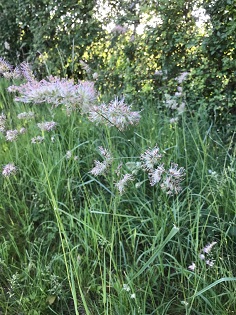
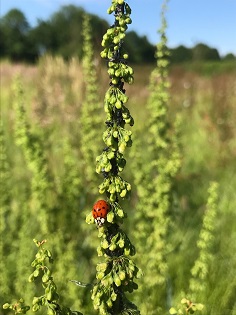
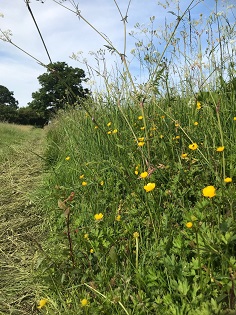
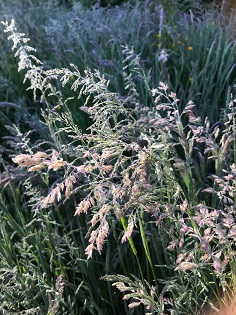
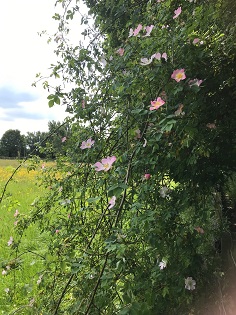
I even love their names! In some fields, the sprouting dark pinky-purple spikes of head high thistles hold a commanding view over Meadow Foxtail grasses, Tufted vetch, clumps of Yorkshire fog flowers, Cocksfoot, Timothy and Creeping and Common Bent grasses, Purple Loose Strife, Yellow Toadflax and one of my favourites, the striking bluish violet flowers of Meadow Crane's Bill that attract a wide variety of bees. But the thistles are nothing in size compared to the 2metre tall red tinged flower clusters of Wild Angelica running alongside our streams, or the really giant Hogweed that towers over everything, whilst gentle, peace-loving water forget-me-not blooms wend their way up their shins and demoiselles and broad-bodied chaser dragon-flies hover nearby. Much further down below, in patches where the sunlight meets the soil such as paths and field margins, the delicate low-growing flowers of common milkwort and yellow flowered Tormentil (like buttercups but with only 4 petals), join purple and white clover, delicate pink bindweed trumpets and small clusters of the dawn and dusk coloured slippers of bird's foot trefoil - all enticing insects galore.
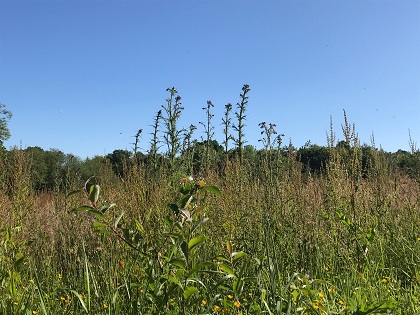
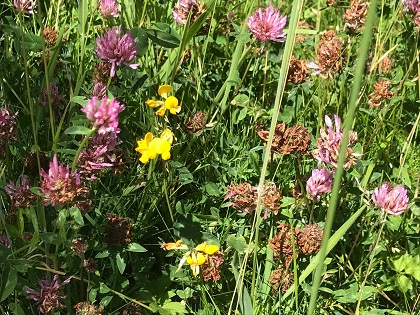
I'm never happier when deeply ensconced in the tranquil setting of a nodding pasture just after dawn - solitary yet least alone as the birds shake out their feathers and voices, the grasses whisper up their secrets and the sheep contentedly munch nearby. One morning I came upon a rather large lizard on a warm patch of open grass, who I think was probably pregnant and warming her swollen belly (the young hatch internally and are born around July) but she quickly darted back into the disguise of the longer meadow and then the only detectable movement was of dozens of tiny grasshoppers. Sometimes, when I've felt someone watching me, I've scanned the golden grass and spied the tips of well-blended russet ears poking slightly above, belying a fox's presence. More recently an off-leash dog, probably chasing the scent of a pheasant, with its owner fields away, surprised both itself and the fawn it disturbed, which had been left by its mother whilst she was feeding. Young deer have little or no scent, so as long as they lie still, they should be well-protected from predators, the mothers returning every 2-3 hours to feed them.
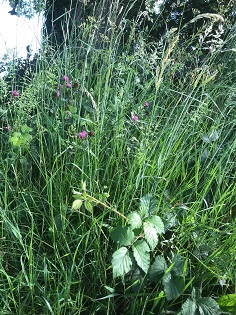
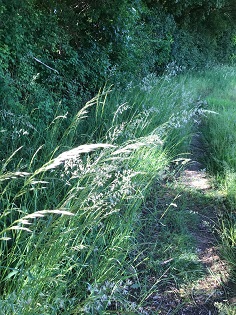
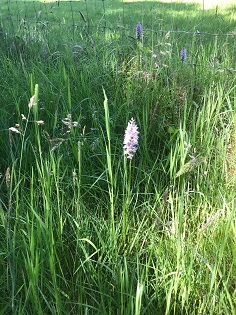
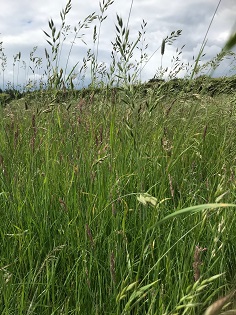
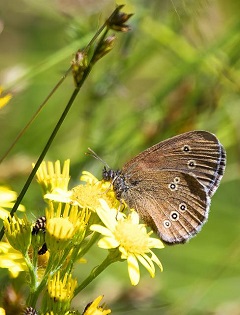
This is also a very good year for meadow buttercups which I've been photographing encasing beetles, bees, flies, a slug and even a crab spider about to pounce on a beetle in the same flower. Found in tall, open grasslands as well as gardens in the south of England, the Misumena vatia is very likely to be lurking somewhere in and amongst one of your own garden herbaceous borders too. Like a chameleon, the females of this amazing spider, that also runs sideways, have the ability to change their colour to match their background - normally flowers with wider faces such as ox-eye daisies, hogweed or thistles. Then they wait with their front legs held out crab-like, for an unsuspecting insect such as a bee or butterfly to visit before pouncing, puncturing their exoskeletons and slurping out their insides. Not a happy ending for our bees or any of the Gatekeepers, Meadow Browns, Ringlets, Painted Ladies and Tortoiseshells currently flitting about - hopefully our winged friends will be drawn instead to July's pale pink blackberry blossom joining dog rose and honeysuckle in our hedgerows. But Crab spiders have predators too, the main ones being wasps, ants, large spiders, lizards, birds and shrews.
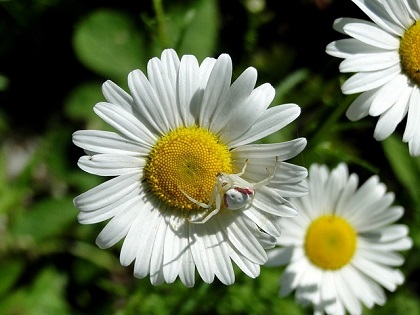
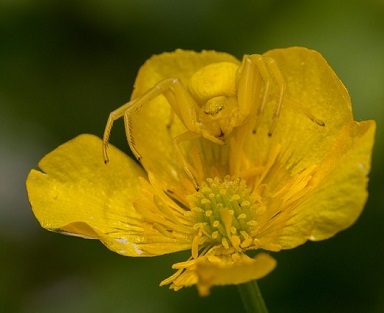
The swallows haven't disappointed with their aerial displays as they've been catching insects on the wing above for their chicks, whilst the happy chatter of flocks of starlings have been plentiful as they ascend upwards from the fields, having feasted on beetles and grubs on or near the ground. I've delighted in watching and hearing the constant, busy high-pitched baby tweets of fledglings of sparrows, dunnocks, great and blue tits, goldfinches and woodpeckers on and around my garden feeders and been lucky enough to see the surreal ghostly glide of barn owls some mornings over the surrounding meadows, maybe looking for mice or voles. Whilst they're not the prey of choice, some barn owls eat bats when prey is scarce. I was intrigued to read recently that some researchers in Italy have discovered a species of bat that they've found which cleverly buzzes like a hornet to effectively puts the owls off feeding on them!
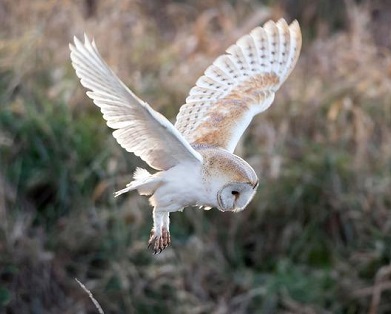
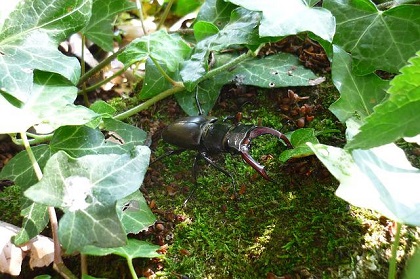
If you spot any stag beetles you could take part in some research yourself. You have until the end of this month (July) to take part in the National Stag Beetle survey - and please do report any sightings online: www.stagbeetles.ptes.org as Sussex numbers seem very low compared to other counties. Britain's largest species of land beetle, with males reaching up to 75mm in length and large antler-like jaws, are usually spotted on the wing as they look for a mate, whereas the smaller females (30-50mm) are more commonly found on the ground or near rotting wood as they hunt for suitable egg laying sites. Both sexes hardly spend any of their lives above the soil, usually only seeing daylight for just 3 months between May-July as they spend at least 3 years under ground going through the various larvae, pupation and moulting stages before eventually metamorphosizing into adults!
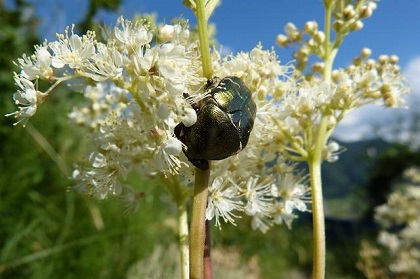
Ralph Waldo Emmerson once wrote, "Many eyes go through the meadow but few see the flowers in it." At the start of July before all of our grasslands are cut and turned into wonderful sweet-smelling hay we can call celebrate National Meadows Day (2nd July) with Plantlife who've revealed that a typical meadow can support nearly 1,400 species of invertebrates, that flower-rich grasslands and meadows can store 500% more carbon than fields of pure grass and that looking at a flower like oxeye daisy for just 6 seconds has been shown to lower your blood pressure (presumably not one bearing a crab spider!) This summer I sincerely hope you can enjoy a pause in the sunshine in, or near, one of our rich surrounding meadows and can enjoy the wonder therein.